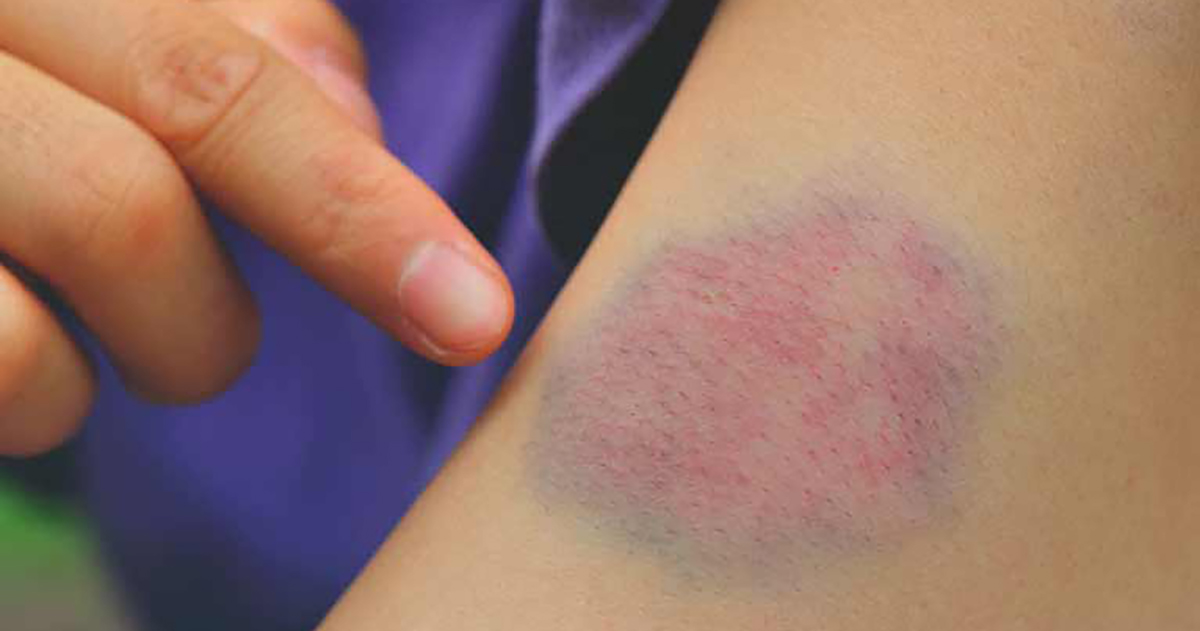Symptoms Of Idiopathic Thrombocytopenic Purpura
Idiopathic thrombocytopenic purpura (ITP) is a medical disorder that leads to excessive and easy bleeding caused by unusually low platelets, which are necessary to help blood clot. The condition can affect both children and adults. Usually, children who develop ITP do so after viral infections, though in most cases, they recover without needing treatment. However, adults tend to have a long-term form of the disorder. There are rare cases in which your platelet count will drop so low that you suffer from dangerous internal bleeding. Fortunately, there are available treatment options.
Excessive Bruising

Individuals may experience excessive bruising, and they may bruise more easily than usual. If you or your child has been bruising much more than usual, it's helpful to get a doctor's opinion. Even if the condition is not idiopathic thrombocytopenic purpura, bruising can be a sign something is wrong with the platelets otherwise. Additionally, the medical professional will probably do a screening to make sure the person isn't living in a situation in which domestic violence is a factor. When a person has ITP, the antibodies the immune system produces will attach to platelets. The platelets are then marked for destruction, which causes a low count.
Continue for more on symptoms of idiopathic thrombocytopenic purpura.
Superficial Bleeding Into Skin

Patients with idiopathic thrombocytopenic purpura will often experience superficial bleeding into the skin. This may be mistaken for a rash at first because rather than appearing as a liquid, the blood appears like a rash of red and purple spots underneath the skin. These pinpoint-sized spots, called petechiae, are places where blood vessels have bled unnecessarily. In the majority of cases, these spots will appear on a person's lower legs.
If you experience worrisome warning signs, it's best to get in contact with your doctor as soon as possible so they can take a look at your spots. They will also ask you about a range of other symptoms to rule out different disorders that can cause petechiae. If the petechiae exist in conjunction with any of the other common symptoms, they may order a blood test to check your platelet count.
Keep reading for more symptoms patients should watch for.
Blood In Urine And Stool

Blood in urine and stool is sometimes harmless, but can also indicate a serious medical condition. For this reason, make an appointment with your doctor immediately after experiencing this symptom. In idiopathic thrombocytopenic purpura patients, this symptom is a sign the patient is bleeding into their internal organs. They will require medical intervention as soon as possible to avoid potentially life-threatening complications.
This symptom, when it occurs on its own, can also be a sign of a number of different issues. Bloody stool indicates a bleed has happened at some point along a person's digestive tract. Common causes of bloody stool are food poisoning, peptic ulcers, anal fissures, and hemorrhoids. Blood in the urine is often harmless, but at the same time, it might point to serious disorders. In almost all cases, the appearance of blood in the urine is a sign there's something wrong with your kidneys.
Bleeding From The Nose Or Gums

Because the blood can't clot, you're more likely to experience noticeable and serious bleeding from nose or gums, such as a nosebleed that doesn't seem to stop, even when you comply with conventional treatments. Contrary to popular belief, you should lean forward rather than back when your nose is bleeding. If this action, combined with pinching the soft part above your nostrils, fails to have an effect, see a doctor.
The same is true of bleeding in the gums, which you're most likely to notice after brushing or flossing. It's common for gums to bleed a little bit, especially if you don't floss often. But heavy bleeding or bleeding that won't stop are not typical symptoms.
Any bleeding that won't stop is considered a medical emergency, regardless of the size of the wound. You need to see your doctor and have tests done to find out why your blood is failing to clot.
Keep reading for more details on symptoms of idiopathic thrombocytopenic purpura.
Heavy Menstrual Flow

It's important for all women to keep track of their periods. If this applies to you, be sure to have a sense of when your period will begin, how your cycle is synced, how long you can expect the bleeding to last for, and how heavy you can expect the bleeding to be. Establishing a baseline for your periods can help you to notice when something is unusual about them.
Heavy menstrual flow is a sign of idiopathic thrombocytopenic purpura. As the uterus lining sheds and is expelled, much more blood than usual will exit the body. In most cases, a heavy period won't cause problems by itself. However, you might experience increased menstrual cramping as a result of the excess blood. If the bleeding is heavy enough, you may also become anemic.
In most cases, ITP patients will experience heavy menstrual flow in conjunction with easy bruising, unusual bleeding, or petechiae. If a heavy menstrual cycle presents without any other classic idiopathic thrombocytopenic purpura symptoms, it's likely the cause is something else, so have your doctor rule out a range of different issues. They may then refer you to an expert like an endocrinologist or a gynecologist, depending on the problem.